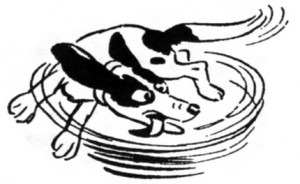
Dog Chasing Tail
The piece is in ABA form, with a slower middle section surrounded by two quick sections. Although some performers start as quickly as possible, it’s usually in the slower middle section where they bog down.
In a survey of some 30 recordings, we never found one at a minute’s length. And, after listening to all of them, we were quite glad because a performance at that speed would be un-listenable.
The quickest performance came in at just over a minute and a half (01:33):
Chopin: Waltz No. 6 in D-Flat Major, Op. 64, No. 1, “Minute” (Eva Suková, piano)
The longest performance came in over a minute longer (02:39):
Chopin: Waltz No. 6 in D-Flat Major, Op. 64, No. 1, “Minute” (Stefan Askenase, piano)
It’s slower, but it’s not that compelling.
When we listen to Claudio Arrau’s slow recording (02:24), however, he makes us re-hear that opening trill as something worth paying attention to:
Chopin: Waltz No. 6 in D-Flat Major, Op. 64, No. 1, “Minute” (Claudio Arrau, piano)
On the repeat of the A section, on the other hand, he treats that opening trill like a real trill because it no longer has a reason to be an introductory sound.
In Lang Lang’s performance (02:16), he gives us a quick first section but then a very languorous middle section. The contrast between the fast and slow sections is too much!
Chopin: Waltz No. 6 in D-Flat Major, Op. 64, No. 1, “Minute” (Lang Lang, piano)
Liberace’s performance (02:03) seems a bit laboured: the hesitant beginning, the lack of flow, and the pauses all contribute to a performance that seems a bit tentative. His repeat of the A section is almost more interesting than the first time we heard it.
Chopin: Waltz No. 6 in D-Flat Major, Op. 64, No. 1, “Minute” (Liberace, piano)
Vladimir Ashkenazy’s performance (01:53) seems rushed although his slide to the final chord is quite elegant.
Chopin: Waltz No. 6 in D-Flat Major, Op. 64, No. 1, “Minute” (Vladimir Ashkenazy, piano)
Idil Biret’s performance (01:48) also feels rushed, particularly when we listen to the left hand.
Chopin: Waltz No. 6 in D-Flat Major, Op. 64, No. 1, “Minute” (Idil Biret, piano)
The performances that take the opening seriously yet at the same time are able to get the piece moving in a dance-line manner that seem the most satisfying. Striking the perfect balance between the rush of the first section and the whist fullness of the second section is difficult for many performers to achieve, and perhaps this one (01:53) does it best.
Chopin: Waltz No. 6 in D-Flat Major, Op. 64, No. 1, “Minute” (Arthur Rubinstein, piano)
If you’re not a pianist, you could always sing it! With words by Lan O’Kun, Barbra Streisand gives us her version of the Waltz:



